Rental Application Form
A rental application is the process of screening potential tenants based on his or her history. The first step involves a lease agreement form containing an applicant’s detailed information, which the rental property owner or property manager would use to conduct the tenant screening.
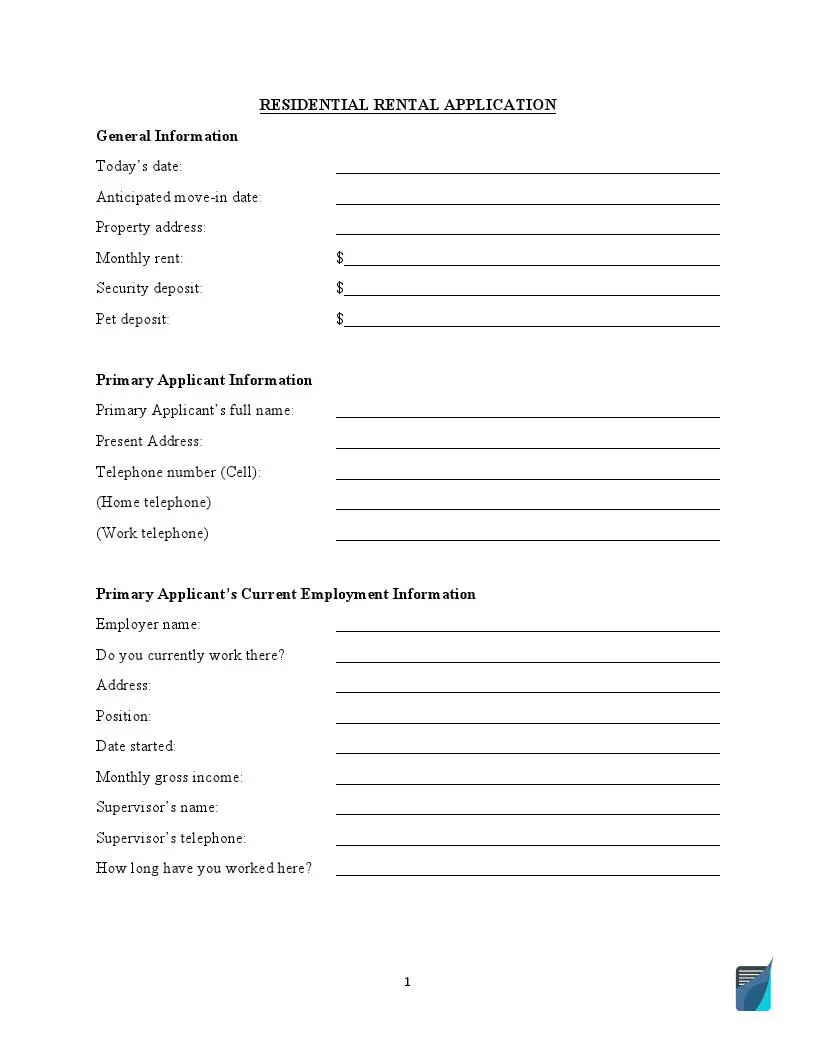
Build Your Document
Answer a few simple questions to make your document in minutes
Save and Print
Save progress and finish on any device, download and print anytime
Sign and Use
Your valid, lawyer-approved document is ready
Why Use a Rental Application Form?
Undergoing a rental or lease application is very beneficial to both the landlord and the tenant as explained below:
Advantages of Using the Form:
- A rental application won’t give all the needed information, but it is a good start when screening the potential tenant.
- It contains detailed personal and contact information, which will speed up the background check and credit check.
- It allows the rental property owner to check if the applicant “fits” with other existing tenants in an apartment or shared property.
- It assesses the tenant’s financial capacity (based on the credit report, employment status, and gross income) and therefore shows if a long-term agreement is possible.
- The form removes the need for an awkward and lengthy interview between the prospective tenant and the rental property owner.
- Should one have a criminal record, he or she is given the chance to explain through the rental application process.
- Using a lease application increases the integrity and validity of the lease agreement.
Consequences of Not Using the Form
- Skipping the rental application process can lead to difficulties when conducting tenant screening.
- The property owner may not be able to properly calculate one’s capacity to pay for the rent.
While much of the potential tenant’s information can be accessed online, most of the crucial information can only be obtained once they give their detailed disclosure.
Rental Application Laws by State
What to Include in a Rental Application Form
Rental applications should be detailed enough to encompass all crucial information about the prospective tenant. These would be the following:
- Contact information
- Employment history
- Rental history
- Sources of income
- Current credit report or credit history
- Co-applicant’s information
- Character references
- Criminal background
- List of occupants
The above information is further detailed in the actual rental application form below.
How to Run Background Check
Once the potential tenant submits the rental application and its attachments, the landlord, broker, or property manager then goes through the tedious process of verifying the information. Don’t worry, though it involves a lot of talking and researching, the reward is in finding a good future renter.
Step 1 — Secure original copies of the paperwork.
Upon submission, landlords must check if the rental application is complete and if it bears the original signature. In exchange for the application form, landlords will then give their prospective tenants a copy of rights as stipulated in the Fair Credit Reporting Act (FCRA). It is also best to let the potential sign a copy of the FCRA disclosure and attach this to the rental application. If the prospective renter is currently residing in another location, he or she can also fill out an online rental application instead of sending over a hardcopy.
Step 2 — Get the rental application fee.
Processing papers and conducting background checks not only take time and effort but a certain amount of money as well. It is therefore standard to ask the potential clients for a rental application fee, which falls anywhere between $18 and $100. Landlords may also choose to reimburse the excess rental application fee.
Step 3 — Check their credit scores.
Popular companies like RentPrep.com or E-Renter.com can do a credit check for landlords. While they charge a fee between $18 and $32, this significantly cuts the application screening time. A good credit score would be 620 and above, but you can set a higher standard for lengthier and more expensive lease contracts (e.g. commercial lease or long-term residential lease). If their credit scores do not meet your desired figures, you may also combine scores of the primary tenant and his/her co-applicant.
Step 4 — Verify other details and character references.
Now, it’s time to sit down and make calls. Landlords or brokers may then call the potential tenant’s current employer, previous employers, previous landlords, and other character references, to verify the details contained in the application. It is best to ask about the applicant’s income, spending behavior, integrity, rental history, employment history, and so on.
Step 5 — Check criminal records.
While most of these are confidential, a quick Google search can help you find news articles that match some details of the renter’s application. This would be easier, of course, if the applicant discloses this in the form. Aside from this, you may also check your state’s sex offender registry. However, do note that landlords cannot reject the application solely based on this.
Step 6 — Compare with other rental applications.
Usually, a rental property will receive several applications. Once all the potential clients are shortlisted based on the results of the rental application screening, you may then pick someone that best matches the profile you are looking for.
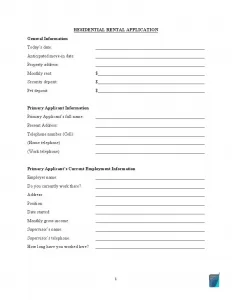
Filling Out the Rental Application Form
Step 1 — Download the Free Rental Application template.
Download a rental application template in PDF format or start filling it out in your browser. You can also try our document builder that will guide you through the process step by step and allow you to customize the application better for your needs.
Step 2 — Provide information about the lease.
Before supplying more detailed information regarding financial capacity, employment details, and character references, the lease application must contain the most relevant information—the basic rental information.
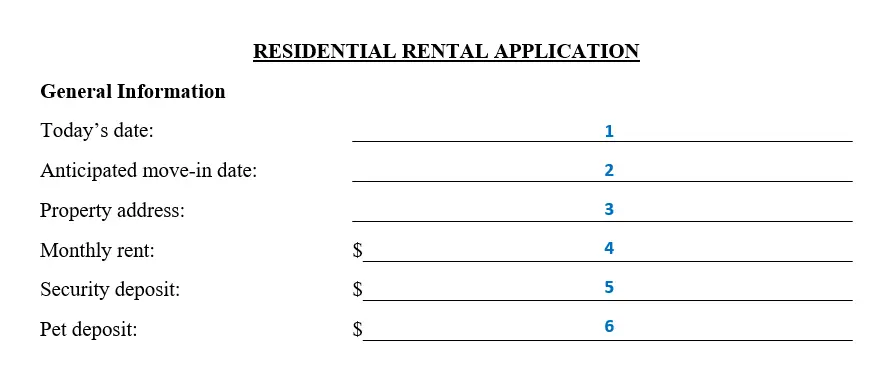
The landlord may take the initiative to fill out this part of the application for the prospective tenant before printing the form:
- Blank 1: Date of visit to the rental property or submission of the application.
- Blank 2: The estimated date when the rental property will be ready.
- Blank 3: The complete address of the rental property.
- Blank 4: Proposed monthly rent (excluding deposits)
- Blank 5: On top of the monthly rent, the tenant must give a security deposit, which is usually equivalent to one to two month’s rent, depending on your state. Write the total amount on the blank provided.
- Blank 6: Since keeping pets on the premises may affect the wear and tear of the rental property, it is important to ask for a pet deposit. The landlord may use this for repair costs.
Step 3 — Write your personal information.

The prospective tenant must then provide general personal information as follows:
- Blank 1: Full name of the prospective tenant
- Blank 2: Write your present address (if moving from another leased premises) or your permanent address (e.g. family home).
- Blank 3: Type in the complete mobile number
- Blank 4: Add your current home’s phone number, including the area code.
- Blank 5: Write your current employer’s phone number with the local number.
- Note: Though it is not required, the applicant may also indicate his or her Social Security Number in this section.
Step 4 — Provide your employer’s details.
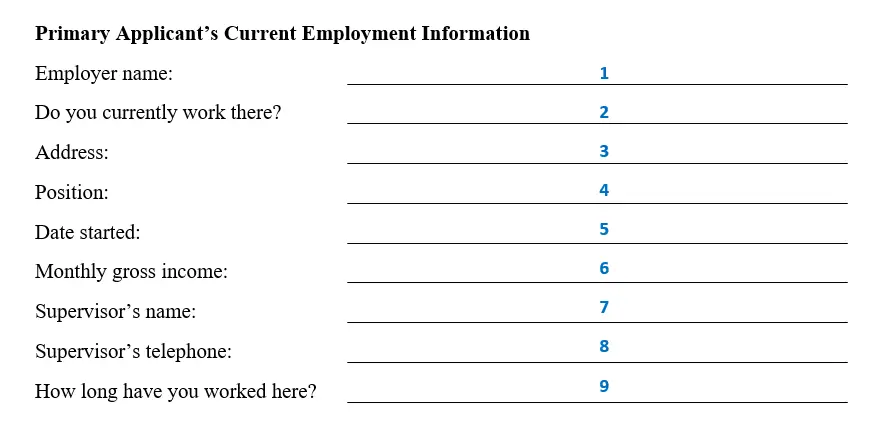
The landlord will want to contact the current employer to confirm the tenant’s source of income as well as the tenant’s character references. For tenants who own businesses, they may provide details about their company. Otherwise, they must provide the following information:
- Blank 1: Full company name
- Blank 2: Write “YES” if you are currently working here and “NO” if you have already resigned.
- Blank 3: Company’s registered address (including specific branch).
- Blank 4: Work title or designation of the tenant
- Blank 5: Refer to your work contract and write your starting date on this blank.
- Blank 6: Write your monthly gross income as it appears on your pay slip. “Gross” refers to the amount before taxes and other deductions.
- Blank 7: Your supervisor’s full name
- Blank 8: Supervisor’s direct line or local number.
- Blank 9: Number of months or years you’ve been at your job
Step 5 — Provide your previous employer’s details.
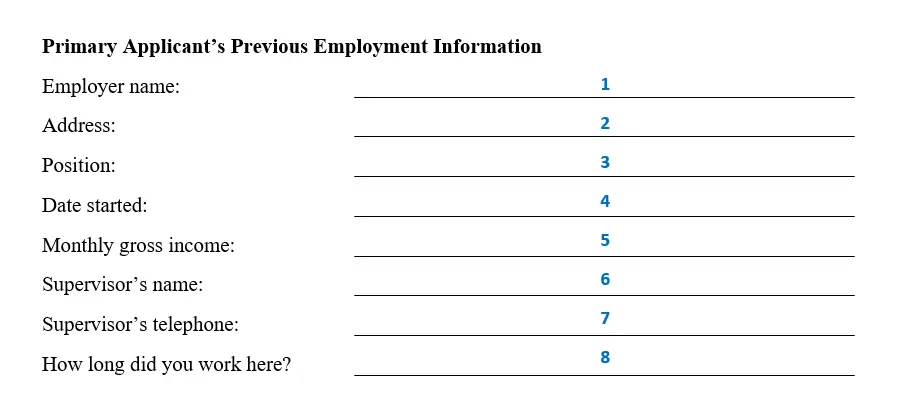
Similar to the format above, provide your previous employer’s details. Make sure the contact information is updated and will direct the landlord to the employer right before your current company. In order to save time, you may also provide a copy of your employment certificate.
Step 6 — Disclose your source of income.

In order to assure the landlord about your capacity to sustain the rental, you may provide the following:
- Blank 1: Updated balance on your bank account (attach a bank statement)
- Blank 2: Write the total value of all your investments.
- Blank 3: If you invested in stocks, write your portfolio’s current market value.
- Blank 4: Disclose any other sources of income (e.g. small business, part-time work, etc.)
Step 7 — Add your co-applicant’s complete information
If your credit score is not enough to secure the lease, you may want to add a co-applicant. However, if you are married, you will normally be obligated to add your spouse’s details.
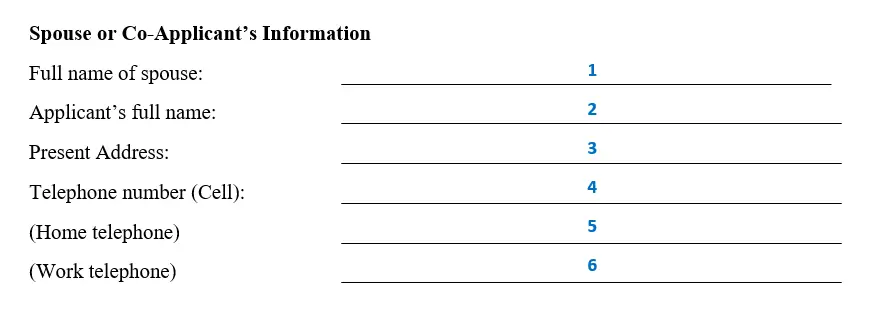
You may simply follow STEP 3 when filling out the portion above.
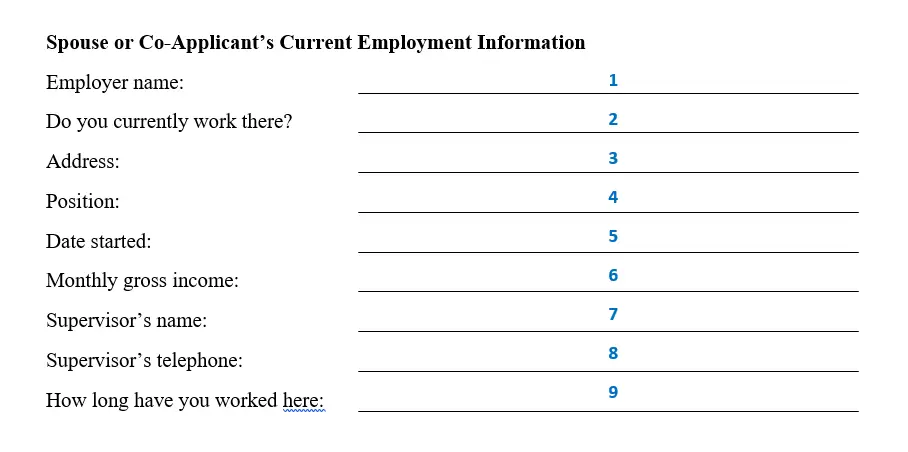
Then, go back to STEP 4 and fill out the next section in the same manner.
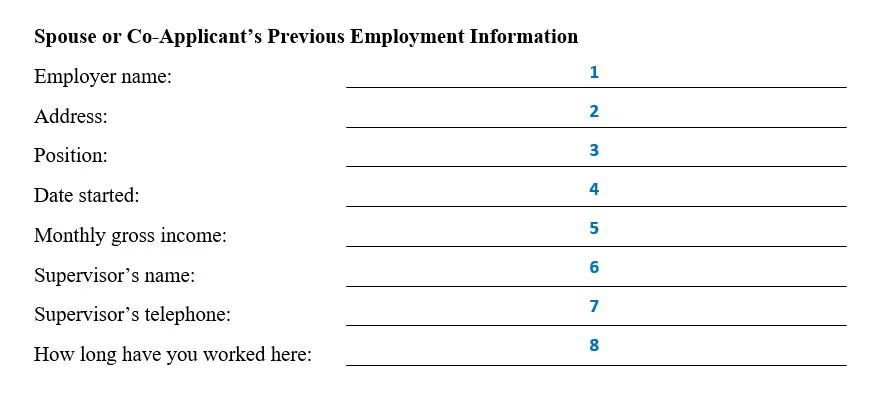
Your co-applicant’s or spouse’s previous work information will also be asked. Follow STEP 5 for this portion.

Lastly, write your co-applicant’s financial information. You may refer to STEP 6.
Step 8 — Provide references.
The landlord will want to confirm your credibility through your references. You will have to provide both financial and personal references.

If you are currently renting, write the following in the section above:
- Blank 1: Current landlord’s full name.
- Blank 2: Date when you started renting the mentioned rental property based on your contract. Then, add your anticipated move-out date.
- Blank 3: Previous landlord’s phone number (write the area code if landline).
- Blank 4: Total monthly payment for the current loaned or rental property.
Now, if you are more comfortable providing details of any existing mortgage, write the following:
- Blank 1: Company name of the lender.
- Blank 2: Date when you moved into the property and your anticipated move-out date (if applicable).
- Blank 3: Lender’s full contact details.
- Blank 4: Total monthly mortgage of said rental property.
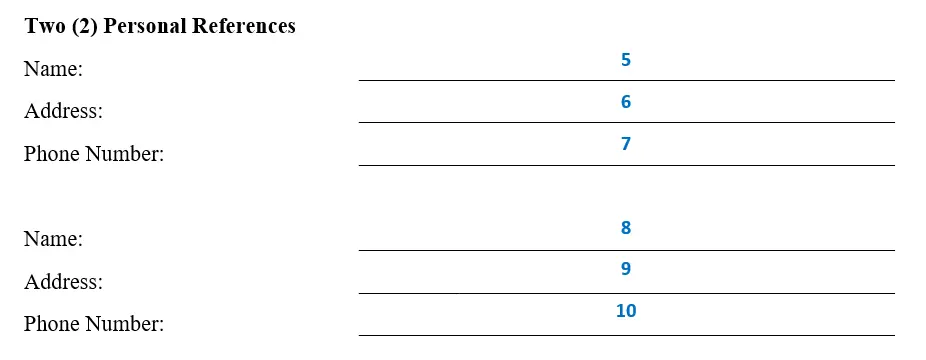
For your character references, you may ask your friends or colleagues to verify your details by inputting the following:
- Blank 1: Their full name
- Blank 2: City or complete address
- Blank 3: Mobile or home phone number.
Step 9 — List the possible occupants aside from the main tenant.
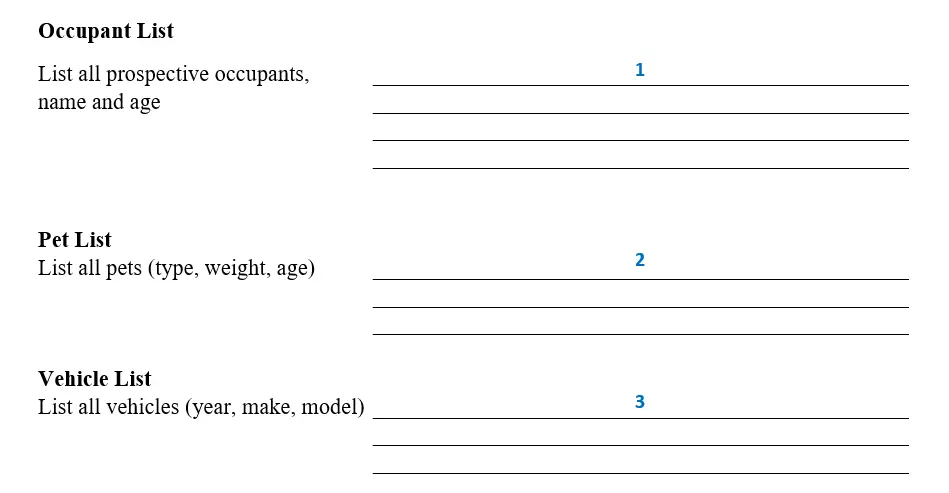
Fill out this section as follows:
- Blank 1: Add the names of those who will be residing in the rental property with you [e.g. “Name (Age), Name (Age),”].
- Blank 2: Write the breed or type of your pet and include its weight and age in parentheses [e.g. “Labrador dog (10 k.g., 2 y/o), Siamese Cat (2 k.g., 3 y/o),”].
- Blank 3: List the vehicle you intend to park on the premises [e.g. “Renault ZOE (2019)”].
Step 10 — Disclose any loans or debts.
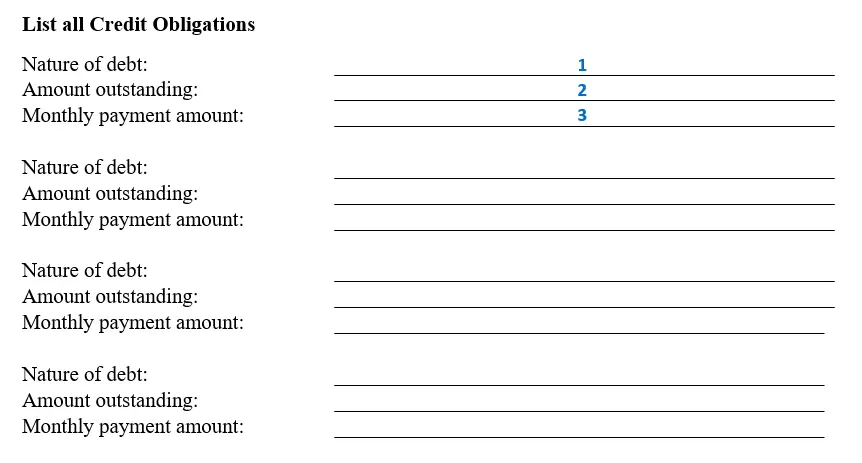
The landlord will also do a background check on your current financial obligations, so it is best to include these in your rental application. By being transparent about these early on, the tenant will gain the landlord’s trust. Simply supply these three details for each of your existing loans or debt on the application form.
- Blank 1: Reason for the loan (e.g. student loans, medical loan, car loan, etc.)
- Blank 2: Remaining amount to be paid overtime.
- Blank 3: Monthly payment that goes toward the crediting company or bank (write the exact amount).
- Note: Fill out this part accurately, since the landlord will verify your history through a credit check.
Step 11 — Clarify any criminal record.

It is best to disclose criminal history through the application form. By doing so, tenants will have a chance to explain their story. Write “NO” on the blank if you have never experienced the following cases, and write “YES” if:
- Blank 1: You were found guilty of a serious crime (e.g. murder or burglary).
- Blank 2: You committed a crime as a first-time offender and were only given “probation.”
- Blank 3: You were forced to leave your previous rental property because of breaking the contract.
- Blank 4: You did not follow your previous rental lease agreement or ended it too early without the landlord’s written approval.
- Blank 5: You formally filed for bankruptcy.
- Blank 6: If your answer to any of the above situations is “YES,” you may provide your explanation in this space.
Step 12 — Sign the rental application.

To complete your rental application, you must provide the following:
- Blank 1: Full name of the landlord or broker.
- Blank 2: Signature of the main tenant.
- Blank 3: Written name of the main tenant
- Blank 4: Secondary tenant’s signature
- Blank 5: Secondary tenant’s written name
No, a rental application can be done without a form. However, using one is advantageous to the landlord, especially for background checking. Typically, tenant screening can be done within 24 hours, but since the landlord or broker will be handling several applications, a week’s processing is standard. Avoid choosing family members as they may hold some strong biases. Landlords are aware of this, so it’s best to cite an officer from your homeowner’s association, another parent from your child’s school, or anyone else that holds a position in your community. This will make your application stronger. Landlords should refrain from discriminatory questions, such as those touching on gender, LGBT families, race, language, and political stand. They must also be careful when phrasing questions and replies about sensitive topics like criminal records and socio-economic status. It is best to prepare a scripted list of questions during the interview stage of the rental application. No, tenants are not required to provide their Social Security Number (SSN), but it would be helpful for their landlord when conducting background checks.Frequently Asked Questions
Is a rental application form required?
How long does it take to process a rental application?
Who to choose as a personal reference for a rental application?
What questions should the landlord refrain from asking?
Is a tenant obliged to provide their Social Security Number?
Though a rental application requires a lot of work both on the part of the landlord and the tenant, going through this process is crucial for the success of the lease. For your convenience, you may use FormsPal’s free rental application template and remember — using rental application forms will save you time during the background check and save your rental properties from being misused by unreliable renters.